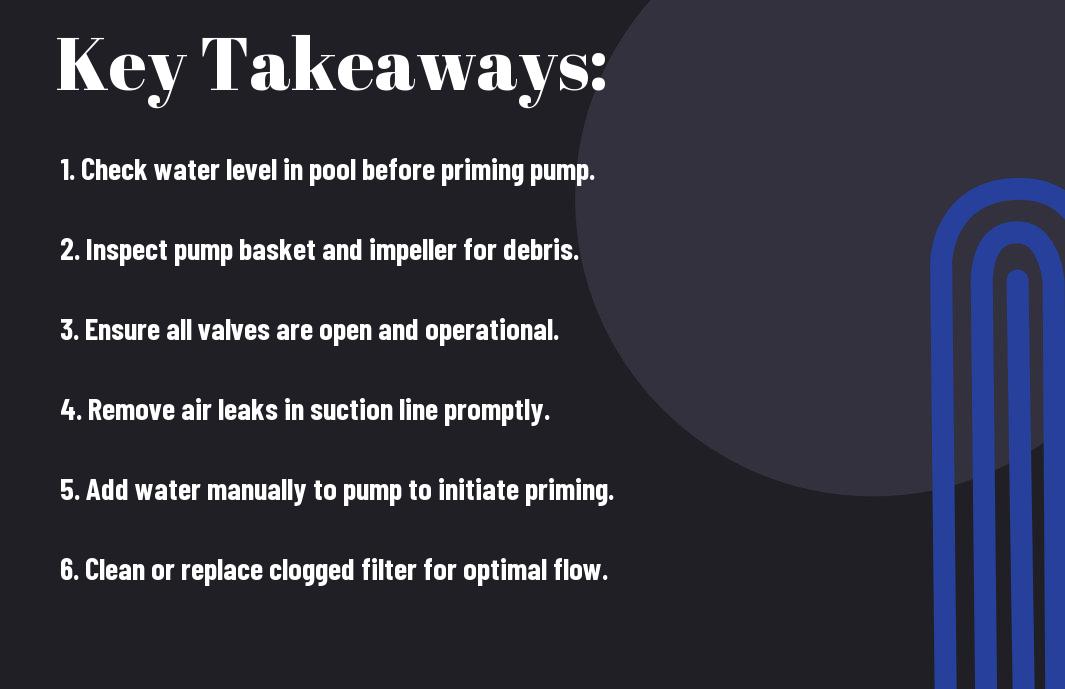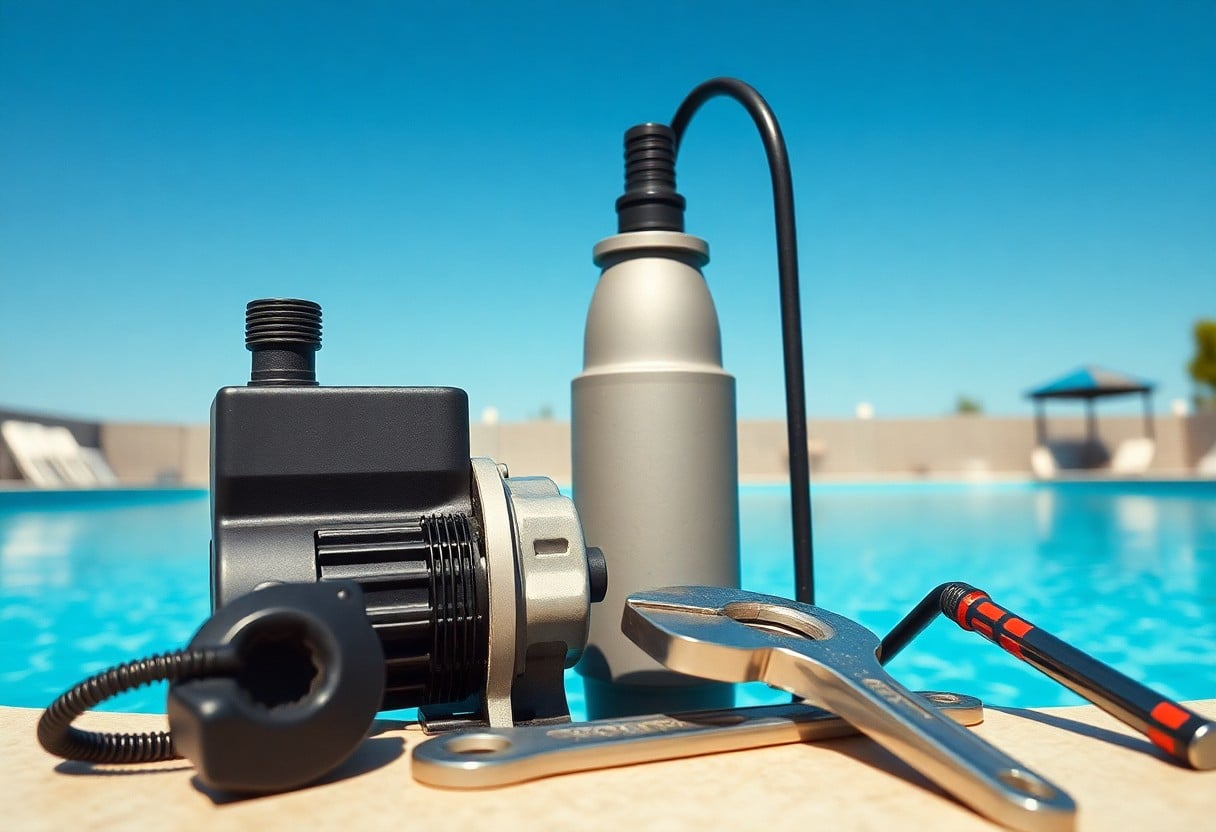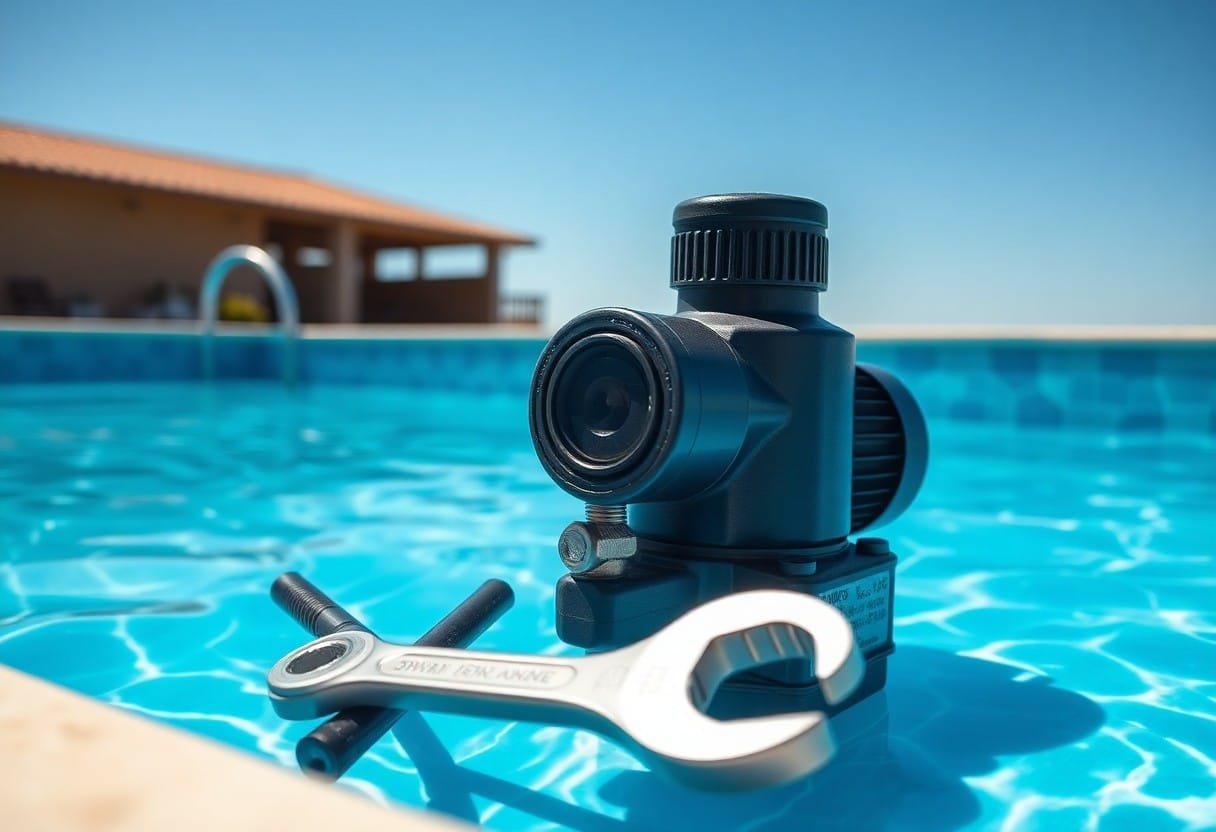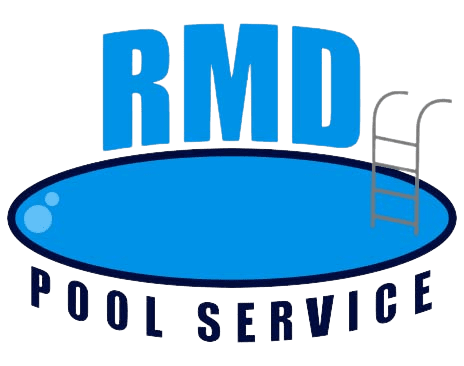Most pool owners experience the frustrating issue of a pool pump that won’t prime at some point. This problem can disrupt your swimming enjoyment and lead to improper water circulation, affecting your pool’s health. In this blog post, you’ll find imperative troubleshooting steps and tips to resolve the issue efficiently. By understanding the common causes and solutions, you can quickly get your pool pump functioning smoothly again, ensuring crystal clear water for you and your family to enjoy.
Diagnosing the Prime Issue
Determining the cause of your pool pump not priming can be a straightforward process if you follow a systematic approach. Start by observing the pump during its operation for any irregularities. Listen for unusual noises, check for vibrations, and keep an eye on the water flow. These signs will help you narrow down the possible issues affecting your pump’s ability to prime properly.
Identifying Symptoms of a Failing Pump
Common symptoms of a failing pump include weak or erratic water flow, air bubbles visible in the pump basket, or a loud grinding noise during operation. If you notice your pump struggling to maintain suction or running hotter than usual, these may be indicators of underlying problems. Addressing these symptoms early can help prevent further damage to your equipment.
Common Causes of Pump Priming Failure
Several factors can lead to pump priming failure, including air leaks in the suction lines, clogged filters, or an incorrect water level in your pool. Additionally, improper pump installation or a malfunctioning motor can hinder the pump’s performance. Identifying these causes can help you determine the most effective solution for restoring your pump’s functionality.
Air leaks are often a primary culprit when pumps fail to prime. This can happen due to loose or damaged fittings, cracked pipes, or worn-out O-rings. Such leaks allow air to enter the system instead of water, disrupting the pump’s ability to create the necessary suction. Similarly, clogged baskets or filters can restrict water flow, preventing the pump from drawing in water efficiently. Regular maintenance, including checking for leaks and keeping filters clean, can significantly reduce the likelihood of priming issues.

Essential Tools for Troubleshooting
Gathering the right tools can make the troubleshooting process for your pool pump much easier. You’ll need a few vitals: a multimeter to check electrical components; a screwdriver set for access panels; a hose for flushing debris; and a vacuum gauge to assess whether you’re maintaining adequate suction. Keeping a bucket handy can also facilitate any spills while you work on your pump. Each of these tools will help you tackle specific issues, ensuring that you can effectively diagnose and rectify the problem.
Necessary Equipment and Preparations
Before you probe troubleshooting, ensure you have all necessary equipment within reach. In addition to the tools mentioned, having lubricant for seals, a replacement motor if needed, and plenty of rags can save you time. Prepare your work area by clearing around the pump, ensuring you have adequate light to see any small components, and making sure your pool’s power source is turned off to promote a safe working environment.
Safety Precautions and Best Practices
Prioritizing safety while working on your pool pump protects both you and your equipment. Always disconnect the power before starting any repairs to avoid electric shock. Wear rubber gloves to guard against electrical components and sharp edges. Keep tools organized and follow the manufacturer’s guidelines for any specific precautions. Take breaks as needed, especially in hot weather, to keep yourself alert and focused on the task at hand.
Being mindful of safety not only keeps you safe during the repair process but also ensures that your equipment remains in good condition. If you encounter stubborn debris or complex electrical issues, don’t hesitate to consult a professional. Rushing the troubleshooting process can lead to injuries or further damage to your pump, ultimately prolonging the repair time and increasing costs. Balance efficiency with caution for the best results.
Step-by-Step Priming Solutions
| Step | Description |
|---|---|
| 1 | Turn off the pump and inspect the suction lines for any visible leaks. |
| 2 | Check the skimmer basket and pump strainer for debris and clean thoroughly. |
| 3 | Fill the pump housing and suction lines with water to eliminate air pockets. |
| 4 | Reconnect and switch on the pump, monitoring for successful priming. |
| 5 | If the pump still fails to prime, repeat the process or consult a professional. |
Correcting Air Leaks in the System
Locating and fixing air leaks in your pool pump’s system is important for proper priming. Inspect all connections, including the pump lid, fittings, and hoses. Any visible cracks or loosened fittings allow air to enter the system, which disrupts proper water flow. You can use Teflon tape on threaded connections and replace worn-out gaskets or o-rings to create a better seal. Running your hand over these connections while the pump is on can help you identify any escaping air, making it easier to target specific leaks.
Evaluating and Adjusting Water Levels
Water level in the skimmer should be maintained within the recommended range for optimal pump performance. Too low a water level can cause air to enter the intake, while too high can lead to water spilling over the skimmer and air intrusion. Aim for the water level to be halfway up the skimmer opening. If you find it low, add water using a hose or other appropriate methods. Conversely, if it’s too high, you may need to drain excess water or adjust your pool fill line accordingly to ensure the pump primes effectively.
When adjusting water levels, consider factors such as recent rainfall or splashing from pool activities, which can raise water levels unexpectedly. Likewise, evaporation during hot weather may require regular checks to ensure water is consistently within the optimal range. Regularly monitoring and adjusting water levels not only helps in efficient pump operation but also supports the overall health of your pool’s filtration system.

Preventive Measures for Long-Term Functionality
Implementing preventive measures will enhance the longevity and efficiency of your pool pump. Regular checks and consistent maintenance practices can help you avoid significant issues down the line. Keeping the pump clean, ensuring proper water levels, and monitoring for wear and tear are important steps to ensure smooth operation. By proactively managing your pool pump, you can enjoy a consistently clean swimming pool without the headache of unexpected breakdowns.
Routine Maintenance Recommendations
Integrate a routine maintenance schedule to keep your pool pump running smoothly. Check the pump basket for debris weekly, inspect the seals and gaskets for signs of wear, and ensure that the impeller is free of blockages. Flushing the filter and keeping the water chemistry balanced further contributes to the health of your pump. These simple actions can extend your pump’s life and improve its performance.
Seasonal Care Tips for Pool Pumps
Seasonal care is vital for maintaining your pool pump’s efficiency. Before winter, make sure to properly winterize your pool and pump to prevent damage from freezing temperatures. During the active pool season, regularly check the water level and adjust as needed to ensure optimal pump performance. Cleaning and lubricating any moving parts can also help your pump operate more effectively.
- Properly winterize your pump to protect it from freezing.
- Check and adjust water levels regularly during peak season.
- Clean and lubricate moving parts for optimal performance.
- Monitor for signs of wear and address issues promptly.
- Any overlooked maintenance can lead to costly repairs.
In addition to the seasonal maintenance tips, consider testing your pump’s efficiency at the start of each season. Performing a pressure test will help you gauge performance and identify any potential issues before they escalate. Keeping an eye on your pump’s operation flow rate ensures that changes can be addressed immediately, maintaining both efficiency and clarity in your pool water.
- Perform a pressure test at the beginning of the season.
- Keep records of maintenance tasks to monitor wear patterns.
- Always have a backup plan for unexpected breakdowns.

When to Call for Professional Help
If you’ve exhausted all basic troubleshooting steps and your pool pump still won’t prime, it might be time to seek professional assistance. Persistent issues could indicate underlying problems that require specialized equipment or advanced knowledge to address. Don’t hesitate if you notice unusual noises, leaks, or inconsistent performance that you’ve been unable to resolve on your own.
Recognizing Complex Problems Beyond DIY
Some pool pump issues can become complex very quickly, especially if they involve electrical components or plumbing connections. If you’ve checked for air leaks, clogs, and prime levels but still encounter persistent problems, it’s a strong indication that a professional’s expertise is necessary.
Choosing the Right Pool Service Technician
Selecting a qualified pool service technician ensures that your pool pump will receive the best care possible. Look for professionals with certified training, strong customer reviews, and a history of tackling similar issues. Additionally, confirm they have experience specifically with the brand of your pool pump, as this can significantly impact the outcome of the repair.
Take the time to ask potential technicians about their approach to diagnosing and fixing pool pump problems. A good technician will not only explain the issue and fix it but also offer guidance on how to prevent similar issues in the future. Ensure they can provide references or testimonials from previous customers. Checking their insurance and licenses protects you and gives peace of mind when inviting them to work on your property.
Summing up
Now that you understand the common reasons behind a pool pump not priming, you can take the necessary steps to troubleshoot and resolve the issue. By checking for air leaks, ensuring the water level is adequate, and verifying that the pump and filter are clean and functioning properly, you can restore efficiency to your pool system. If these solutions don’t work, consulting a professional might be your best option to ensure your pool operates smoothly all season long.
